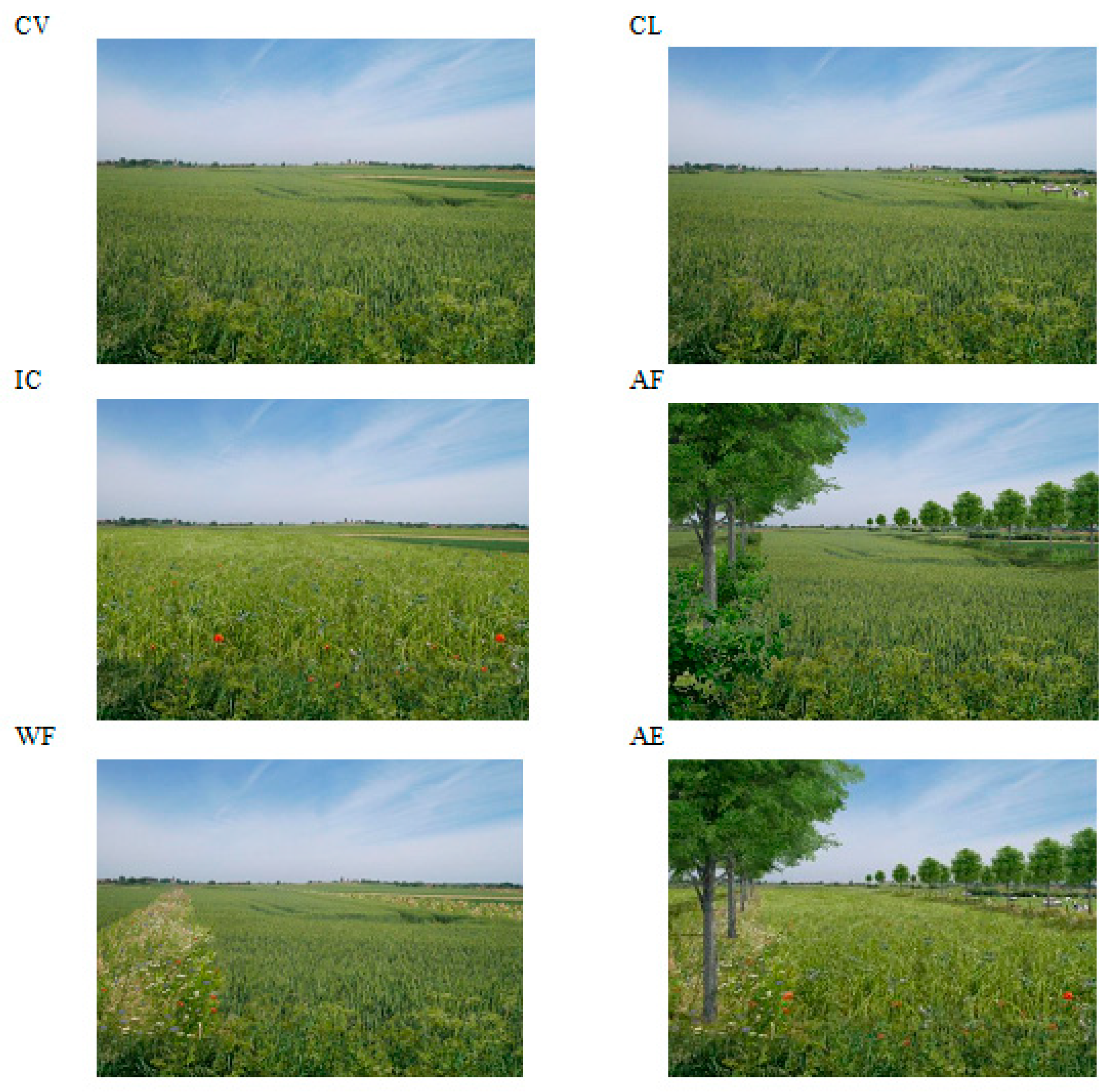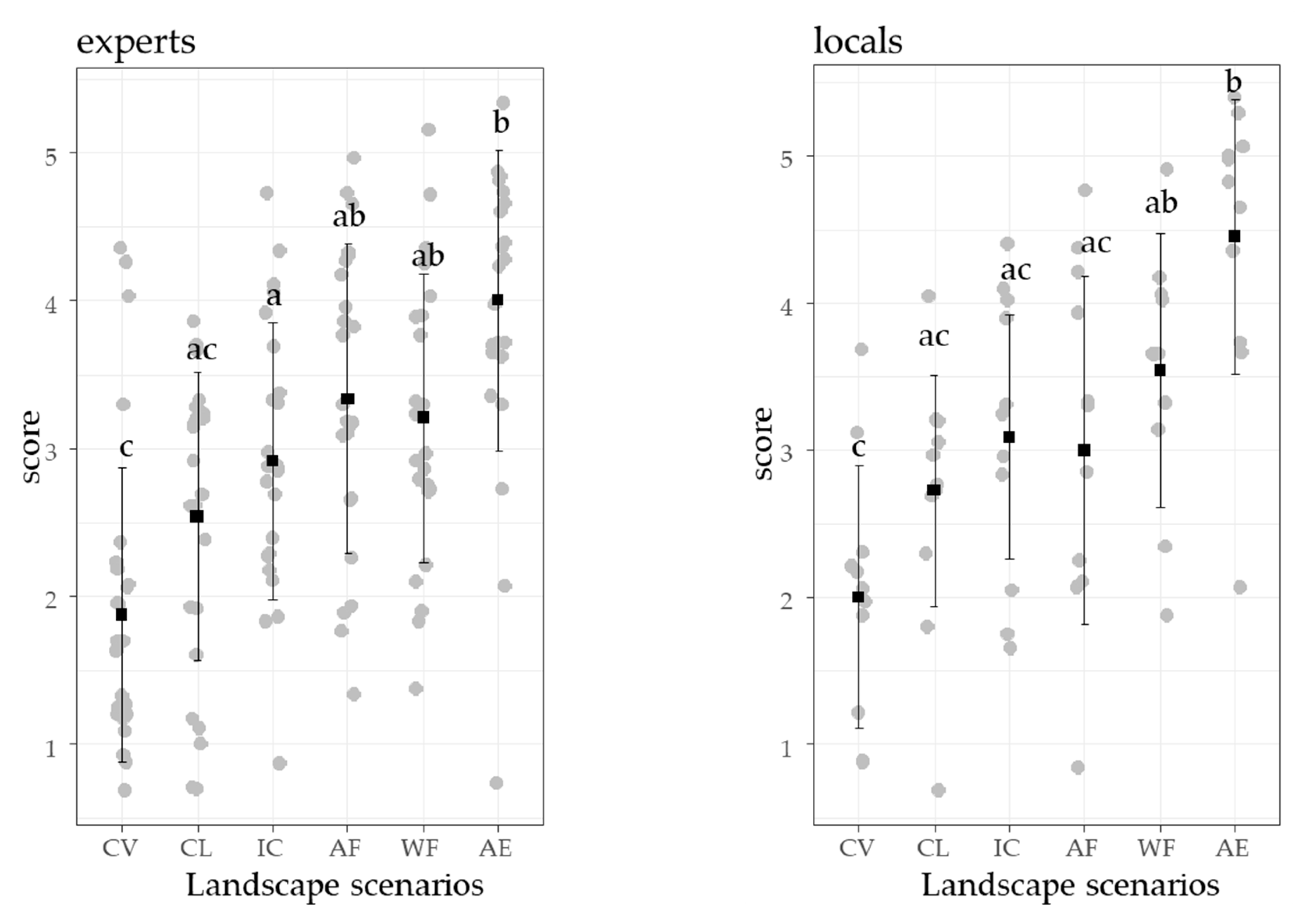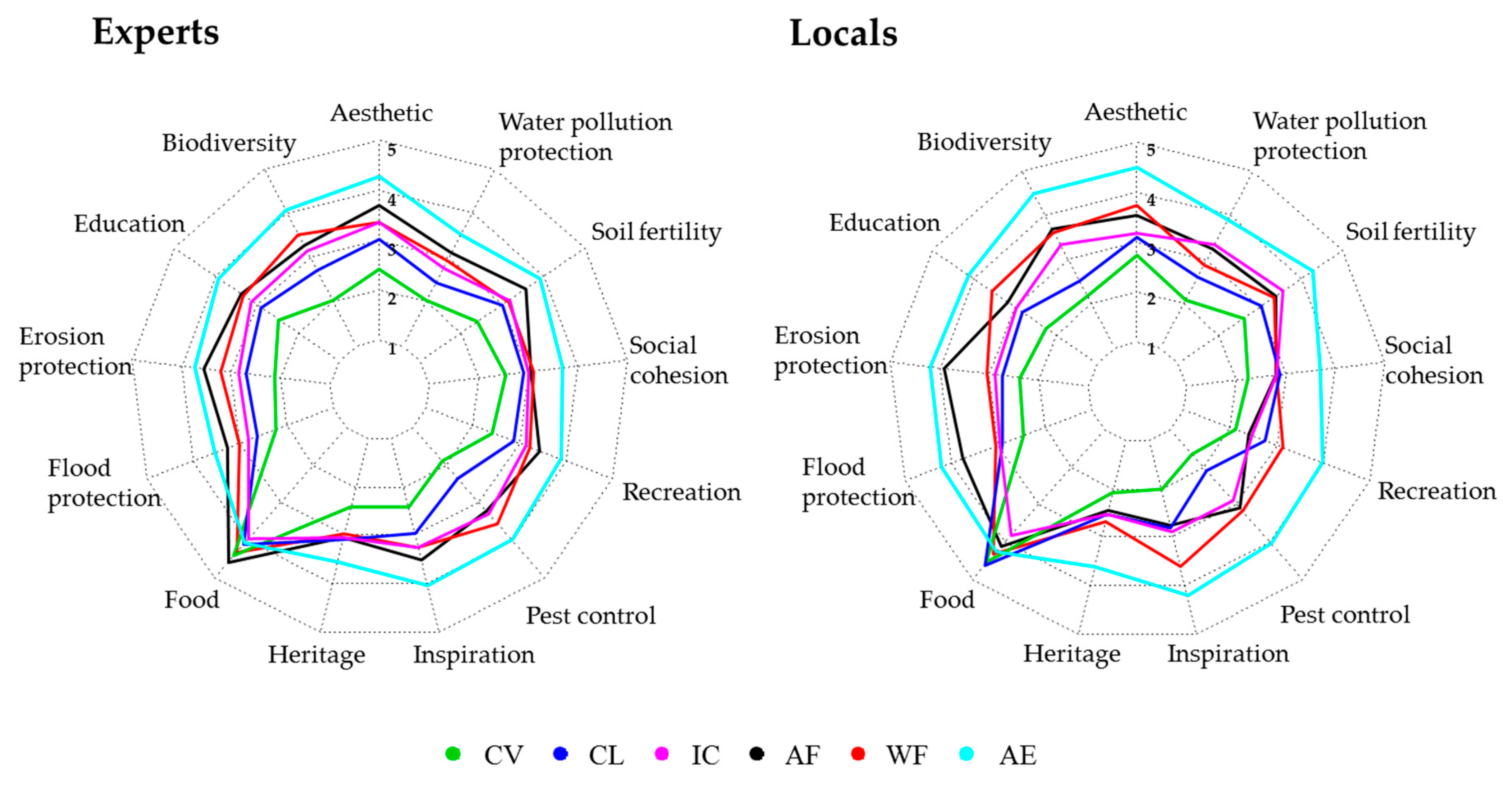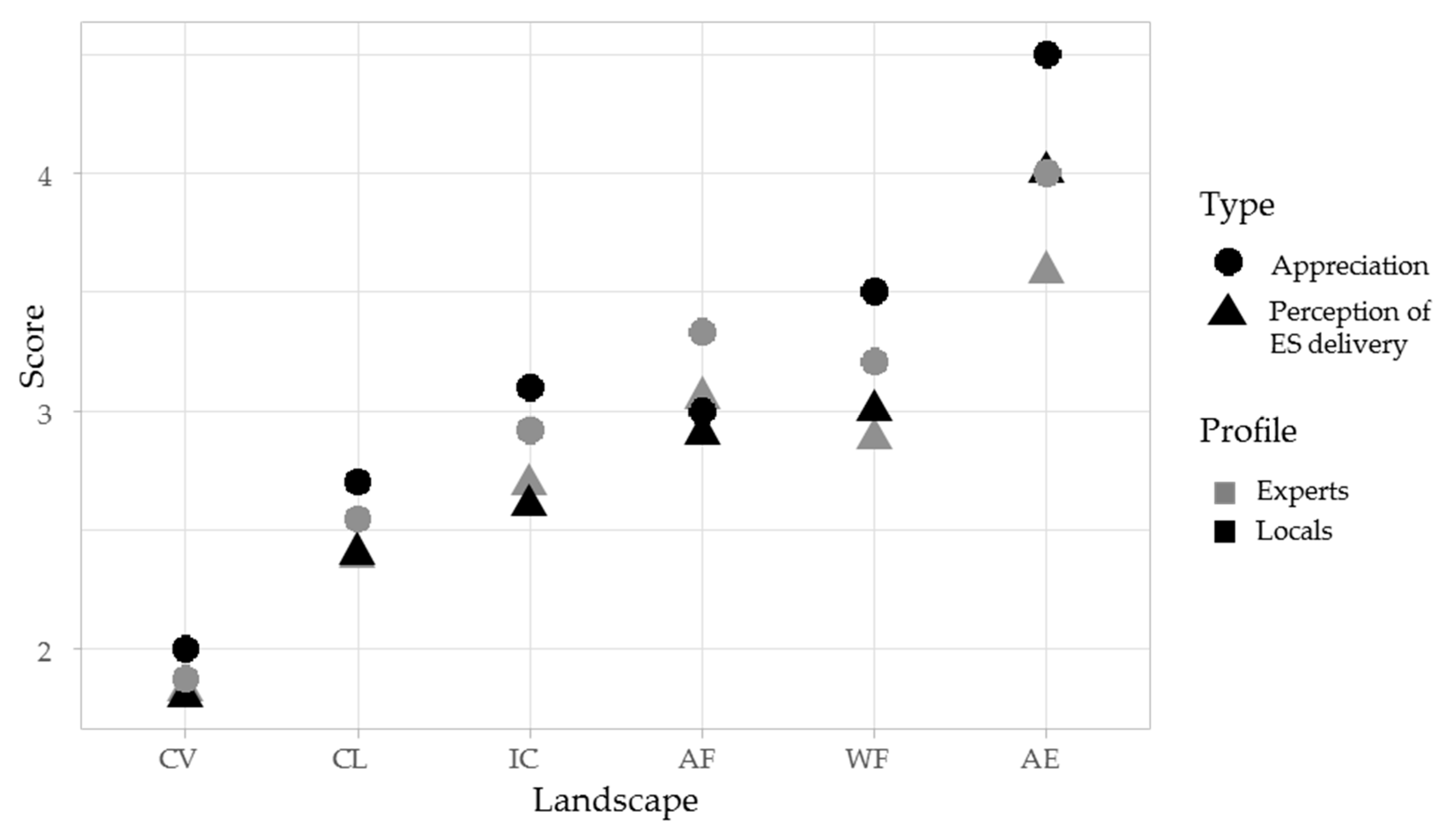How Are Landscapes under Agroecological Transition Perceived and Appreciated? A Belgian Case Study
Abstract
1. Introduction
2. Methods
2.1. Study Area
2.2. Construction of Landscape Scenarios
2.3. Elicitation of Appreciation and Perception of Ecosystem Service Delivery Across Scenarios
2.4. Biophysical Field-Based Measurements of Ecosystem Services
2.5. Statistical Analyses
3. Results
3.1. Sample Characteristics
3.2. Appreciation of Agroecological Landscapes
3.2.1. Outcomes of the Scoring Question
3.2.2. Outcomes of the Open Question about Positive and Negative Feelings
3.3. Perception of Ecosystem Service Delivery in Agroecological Landscapes
3.3.1. Locals’ Perceptions of Ecosystem Service Delivery with Regard to Experts’ Perceptions
3.3.2. Locals’ Perceptions with Regard to Field ES Measurements
4. Discussion
4.1. Study Limitations
4.2. Agroecology Perceived as a Synergetic Whole
4.3. Agroecology Multi-Performance Assessment: Bridging the ES Gap
4.4. Research Avenues to Foster Agroecological Transitions
5. Conclusions
Author Contributions
Funding
Acknowledgments
Conflicts of Interest
References
- Tilman, D.; Balzer, C.; Hill, J.; Befort, B.L. Global Food demand and the sustainable intensification of agriculture. Proc. Natl. Acad. Sci. USA 2011, 108, 20260–20264. [Google Scholar] [CrossRef]
- Ponisio, L.C.; Kremen, C. System-level approach needed to evaluate the transition to more sustainable agriculture. Proc. R. Soc. B Biol. Sci. 2016, 283. [Google Scholar] [CrossRef] [PubMed]
- Gliessman, S. Agroecology of Sustainable Food Systems; CRC Press Taylor & Francis Group: London, UK, 2006. [Google Scholar]
- Altieri, M.A.; Nicholls, C.I.; Henao, A.; Lana, M.A. Agroecology and the design of climate change-resilient farming systems. Agron. Sustain. Dev. 2015, 35, 869–890. [Google Scholar] [CrossRef]
- Hatt, S.; Artru, S.; Brédart, D.; Lassois, L.; Francis, F.; Haubruge, E.; Garré, S.; Stassart, P.; Dufrêne, M.; Monty, A.; et al. Toward a sustainable development within agriculture: A review of what agroecology suggests. Biotechnol. Agron. Soc. Environ. 2016, 20, 215–224. [Google Scholar]
- Zhang, W.; Ricketts, T.H.; Kremen, C.; Carney, K.; Swinton, S.M. Ecosystem services and dis-services to agriculture. Ecol. Econ. 2007, 64, 253–260. [Google Scholar] [CrossRef]
- Dale, V.H.; Kline, K.L.; Kaffka, S.R.; Langeveld, J.W.A. A landscape perspective on sustainability of agricultural systems. Landsc. Ecol. 2012, 28, 1111–1123. [Google Scholar] [CrossRef]
- Power, A.G. Ecosystem services and agriculture: Tradeoffs and synergies. Philos. Trans. R. Soc. B Biol. Sci. 2010, 365, 2959–2971. [Google Scholar] [CrossRef]
- Dalgaard, T.; Hutchings, N.J.; Porter, J.R. Agroecology, scaling and interdisciplinarity. Agric. Ecosyst. Environ. 2003, 100, 39–51. [Google Scholar] [CrossRef]
- Wezel, A.; Casagrande, M.; Celette, F.; Vian, J.-F.; Ferrer, A.; Peigné, J. Agroecological practices for sustainable agriculture. A review. Agron. Sustain. Dev. 2013, 34, 1–20. [Google Scholar] [CrossRef]
- Van Der Ploeg, J.D. The New Peasantries: Struggles for Autonomy and Sustainability in an Era of Empire and Globalization; Earthscan: London, UK, 2008. [Google Scholar]
- European Commission Database—Eurostat. Available online: http://ec.europa.eu/eurostat/web/agriculture/data/database (accessed on 2 June 2017).
- European Commission. Agri-Environment Schemes: Impacts on the Agricultural Environment; Science for Environment Policy: Bristol, UK, 2017. [Google Scholar]
- Knowler, D.; Bradshaw, B. Farmers’ adoption of conservation agriculture: A review and synthesis of recent research. Food Policy 2007, 32, 25–48. [Google Scholar] [CrossRef]
- Renting, H.; Marsden, T.K.; Banks, J. Understanding Alternative Food Networks: Exploring the Role of Short Food Supply Chains in Rural Development. Environ. Plan. A 2003, 35, 393–411. [Google Scholar] [CrossRef]
- Duru, M.; Therond, O.; Martin, G.; Martin-Clouaire, R.; Magne, M.-A.; Justes, E.; Journet, E.-P.; Aubertot, J.-N.; Savary, S.; Bergez, J.-E.; et al. How to implement biodiversity-based agriculture to enhance ecosystem services: A review. Agron. Sustain. Dev. 2015, 35, 1259–1281. [Google Scholar] [CrossRef]
- Bell, M.M.; Lyon, A.; Gratton, C.; Jackson, R.D. Commentary: The productivity of variability: An agroecological hypothesis. Int. J. Agric. Sustain. 2008, 6, 233–235. [Google Scholar] [CrossRef]
- Lyon, A.; Bell, M.M.; Gratton, C.; Jackson, R. Farming without a recipe: Wisconsin graziers and new directions for agricultural science. J. Rural Stud. 2011, 27, 384–393. [Google Scholar] [CrossRef]
- Louah, L.; Visser, M.; Baltazar, S.; Delobel, V. Changements de postures du chercheur, de l’agriculteur et de l’enseignant pour l’innovation agroécologique paysanne. Pour 2015, 226, 5–10. [Google Scholar] [CrossRef]
- Réseau des Fermes Novatrices Réseau des Fermes Novatrices. Available online: http://fermesnovatrices.be/wakka.php?wiki=PagePrincipale (accessed on 2 June 2017).
- Vanderheyden, V.; Van der Horst, D.; Van Rompaey, A.; Schmitz, S. Perceiving the Ordinary: A Study of Everyday Landscapes in Belgium: A Study of Everyday Landscapes in Belgium. Tijdschr. Voor Econ. Soc. Geogr. 2014, 105, 591–603. [Google Scholar] [CrossRef]
- Tengberg, A.; Fredholm, S.; Eliasson, I.; Knez, I.; Saltzman, K.; Wetterberg, O. Cultural ecosystem services provided by landscapes: Assessment of heritage values and identity. Ecosyst. Serv. 2012, 2, 14–26. [Google Scholar] [CrossRef]
- Lin, B.B.; Fuller, R.A. Sharing or sparing? How should we grow the world’s cities? J. Appl. Ecol. 2013, 50, 1161–1168. [Google Scholar] [CrossRef]
- Council of Europe. Pan-European Biological and Landscape Diversity Strategy; Nature and Environment; Council of Europe Press: Strasbourg, France, 1995. [Google Scholar]
- Council of Europe. European Landscape Convention; Council of Europe Press: Strasbourg, France, 2000. [Google Scholar]
- Schmidt, K.; Sachse, R.; Walz, A. Current role of social benefits in ecosystem service assessments. Landsc. Urban Plan. 2016, 149, 49–64. [Google Scholar] [CrossRef]
- Lamarque, P.; Meyfroidt, P.; Nettier, B.; Lavorel, S. How Ecosystem Services Knowledge and Values Influence Farmers’ Decision-Making. PLoS ONE 2014, 9, e107572. [Google Scholar] [CrossRef]
- Keune, H.; Dendoncker, N.; Popa, F.; Sander, J.; Kampelmann, S.; Boeraeve, F.; Dufrêne, M.; Bauler, T.; Casaer, J.; Cerulus, T.; et al. Emerging ecosystem services governance issues in the Belgium ecosystem services community of practice. Ecosyst. Serv. 2015, 16, 212–219. [Google Scholar] [CrossRef]
- Dendoncker, N.; Boeraeve, F.; Crouzat, E.; Dufrêne, M.; König, A.; Barnaud, C. How can integrated valuation of ecosystem services help understanding and steering agroecological transitions? Ecol. Soc. 2018, 23. [Google Scholar] [CrossRef]
- Lindemann-Matthies, P.; Briegel, R.; Schüpbach, B.; Junge, X. Aesthetic preference for a Swiss alpine landscape: The impact of different agricultural land-use with different biodiversity. Landsc. Urban Plan. 2010, 98, 99–109. [Google Scholar] [CrossRef]
- Junge, X.; Schüpbach, B.; Walter, T.; Schmid, B.; Lindemann-Matthies, P. Aesthetic quality of agricultural landscape elements in different seasonal stages in Switzerland. Landsc. Urban Plan. 2015, 133, 67–77. [Google Scholar] [CrossRef]
- Klein, L.R.; Hendrix, W.G.; Lohr, V.I.; Kaytes, J.B.; Sayler, R.D.; Swanson, M.E.; Elliot, W.J.; Reganold, J.P. Linking ecology and aesthetics in sustainable agricultural landscapes: Lessons from the Palouse region of Washington, U.S.A. Landsc. Urban Plan. 2015, 134, 195–209. [Google Scholar] [CrossRef]
- Bernués, A.; Tello-García, E.; Rodríguez-Ortega, T.; Ripoll-Bosch, R.; Casasús, I. Agricultural practices, ecosystem services and sustainability in High Nature Value farmland: Unraveling the perceptions of farmers and nonfarmers. Land Use Policy 2016, 59, 130–142. [Google Scholar] [CrossRef]
- Hicks, C.C.; Graham, N.A.J.; Cinner, J.E. Synergies and tradeoffs in how managers, scientists, and fishers value coral reef ecosystem services. Glob. Environ. Chang. 2013, 23, 1444–1453. [Google Scholar] [CrossRef]
- Carnol, M.; Baeten, L.; Branquart, E.; Gregoire, J.-C.; Heughebaert, A.; Muys, B.; Ponette, Q.; Verheyen, K. Ecosystem services of mixed species forest stands and monocultures: Comparing practitioners’ and scientists’ perceptions with formal scientific knowledge. Forestry 2014, 87, 639–653. [Google Scholar] [CrossRef]
- García-Llorente, M.; Martín-López, B.; Iniesta-Arandia, I.; López-Santiago, C.A.; Aguilera, P.A.; Montes, C. The role of multi-functionality in social preferences toward semi-arid rural landscapes: An ecosystem service approach. Environ. Sci. Policy 2012, 19–20, 136–146. [Google Scholar]
- Van Berkel, D.B.; Verburg, P.H. Spatial quantification and valuation of cultural ecosystem services in an agricultural landscape. Ecol. Indic. 2014, 37, 163–174. [Google Scholar] [CrossRef]
- Cáceres, D.M.; Tapella, E.; Quétier, F.; Díaz, S. The social value of biodiversity and ecosystem services from the perspectives of different social actors. Ecol. Soc. 2015, 20, 62. [Google Scholar] [CrossRef]
- Logsdon, R.A.; Kalcic, M.M.; Trybula, E.M.; Chaubey, I.; Frankenberger, J.R. Ecosystem services and Indiana agriculture: Farmers’ and conservationists’ perceptions. Int. J. Biodivers. Sci. Ecosyst. Serv. Manag. 2015, 11, 264–282. [Google Scholar] [CrossRef]
- Malinga, R.; Gordon, L.J.; Lindborg, R.; Jewitt, G. Using Participatory Scenario Planning to Identify Ecosystem Services in Changing Landscapes. Ecol. Soc. 2013, 18, 10. [Google Scholar] [CrossRef]
- Mascarenhas, A.; Ramos, T.B.; Haase, D.; Santos, R. Participatory selection of ecosystem services for spatial planning: Insights from the Lisbon Metropolitan Area, Portugal. Ecosyst. Serv. 2016, 18, 87–99. [Google Scholar] [CrossRef]
- Boeraeve, F.; Dufrene, M.; De Vreese, R.; Jacobs, S.; Pipart, N.; Turkelboom, F.; Verheyden, W.; Dendoncker, N. Participatory identification and selection of ecosystem services: Building on field experiences. Ecol. Soc. 2018, 23, 27. [Google Scholar] [CrossRef]
- McCall, M.K. Seeking good governance in participatory-GISA: Review ofprocesses and governance dimensions in applying GIS to participatory spatial planning. Habitat Int. 2003, 27, 549–573. [Google Scholar] [CrossRef]
- Andersson, E.; Nykvist, B.; Malinga, R.; Jaramillo, F.; Lindborg, R. A social–ecological analysis of ecosystem services in two different farming systems. AMBIO 2015, 44, 102–112. [Google Scholar] [CrossRef]
- Boeraeve, F.; Dendoncker, N.; Degrune, F.; Cornelis, J.-T.; Dufrêne, M. Contribution of agroecological farming systems to the delivery of ecosystem services. J. Environ. Manag. 2020, 260, 109576. [Google Scholar] [CrossRef]
- CPDT. Les Territoires Paysagers de Wallonie; Sarlet, D., Ed.; Etudes et Documents: Wallonia, Belgium, 2004. [Google Scholar]
- Scott, A. Assessing Public Perception of Landscape: The LANDMAP experience. Landsc. Res. 2002, 27, 271–295. [Google Scholar] [CrossRef]
- Howley, P.; Donoghue, C.O.; Hynes, S. Exploring public preferences for traditional farming landscapes. Landsc. Urban Plan. 2012, 104, 66–74. [Google Scholar] [CrossRef]
- Smith, H.F.; Sullivan, C.A. Ecosystem services within agricultural landscapes—Farmers’ perceptions. Ecol. Econ. 2014, 98, 72–80. [Google Scholar] [CrossRef]
- Raymond, C.M.; Fazey, I.; Reed, M.S.; Stringer, L.C.; Robinson, G.M.; Evely, A.C. Integrating local and scientific knowledge for environmental management. J. Environ. Manag. 2010, 91, 1766–1777. [Google Scholar] [CrossRef] [PubMed]
- Belgian Biodiversity Platform BElgian Ecosystems and Society Community (BEES). Available online: http://www.beescommunity.be/en/ (accessed on 1 September 2017).
- Bates, D.M.; Maechler, M. Package “lme4”: Linear Mixed-Effects Models Using “Eigen” and S4. 2018. Available online: https://cran.r-project.org/web/packages/lme4/index.html (accessed on 1 September 2017).
- Hothorn, T.; Bretz, F.; Westfall, P. Simultaneous Inference in General Parametric Models. Biometr. J. 2008, 50, 346–363. [Google Scholar] [CrossRef] [PubMed]
- Fox, J.; Weisberg, S.; Price, B. Package “car”: Companion to Applied Regression; SAGE Publications: Thousand Oaks, CA, USA, 2018. [Google Scholar]
- Van Zanten, B.T.; Verburg, P.H.; Koetse, M.J.; van Beukering, P.J.H. Preferences for European agrarian landscapes: A meta-analysis of case studies. Landsc. Urban Plan. 2014, 132, 89–101. [Google Scholar] [CrossRef]
- Plieninger, T.; Dijks, S.; Oteros-Rozas, E.; Bieling, C. Assessing, mapping, and quantifying cultural ecosystem services at community level. Land Use Policy 2013, 33, 118–129. [Google Scholar] [CrossRef]
- Barrett, T.L.; Farina, A.; Barrett, G.W. Positioning aesthetic landscape as economy. Landsc. Ecol. 2009, 24, 299–307. [Google Scholar] [CrossRef]
- Falk, J.H.; Balling, J.D. Evolutionary Influence on Human Landscape Preference. Environ. Behav. 2010, 42, 479–493. [Google Scholar] [CrossRef]
- Page, G.; Bellotti, B. Farmers value on-farm ecosystem services as important, but what are the impediments to participation in PES schemes? Sci. Total Environ. 2015, 515–516, 12–19. [Google Scholar] [CrossRef]
- Kremen, C.; Miles, A. Ecosystem Services in Biologically Diversified versus Conventional Farming Systems: Benefits, Externalities, and Trade-Offs. Ecol. Soc. 2012, 17, 40. [Google Scholar] [CrossRef]
- Robertson, G.P.; Gross, K.L.; Hamilton, S.K.; Landis, D.A.; Schmidt, T.M.; Snapp, S.S.; Swinton, S.M. Farming for Ecosystem Services: An Ecological Approach to Production Agriculture. Ecol. Agric. Landsc. Long-Term Res. Path Sustain. 2014, 64, 404–415. [Google Scholar] [CrossRef]
- Schipanski, M.E.; Barbercheck, M.; Douglas, M.R.; Finney, D.M.; Haider, K.; Kaye, J.P.; Kemanian, A.R.; Mortensen, D.A.; Ryan, M.R.; Tooker, J.; et al. A framework for evaluating ecosystem services provided by cover crops in agroecosystems. Agric. Syst. 2014, 125, 12–22. [Google Scholar] [CrossRef]
- Syswerda, S.P.; Robertson, G.P. Ecosystem services along a management gradient in Michigan (USA) cropping systems. Agric. Ecosyst. Environ. 2014, 189, 28–35. [Google Scholar] [CrossRef]
- Garbach, K.; Milder, J.C.; DeClerck, F.A.J.; Montenegro de Wit, M.; Driscoll, L.; Gemmill-Herren, B. Examining multi-functionality for crop yield and ecosystem services in five systems of agroecological intensification. Int. J. Agric. Sustain. 2016, 11–28. [Google Scholar] [CrossRef]
- Rapidel, B.; Ripoche, A.; Allinne, C.; Metay, A.; Deheuvels, O.; Lamanda, N.; Blazy, J.-M.; Valdés-Gómez, H.; Gary, C. Analysis of ecosystem services trade-offs to design agroecosystems with perennial crops. Agron. Sustain. Dev. 2015, 35, 1373–1390. [Google Scholar] [CrossRef]
- Jacobs, S.; Martín-López, B.; Barton, D.N.; Dunford, R.; Harrison, P.A.; Kelemen, E.; Saarikoski, H.; Termansen, M.; García-Llorente, M.; Gómez-Baggethun, E.; et al. The means determine the end—Pursuing integrated valuation in practice. Ecosyst. Serv. 2018, 29, 515–528. [Google Scholar] [CrossRef]
- Chan, A. Reflection, reflexivity, reconceptualisation: Life story inquiry and the complex positionings of a researcher. Reconceptualizing Educ. Res. Methodol. 2017, 8, 27–39. [Google Scholar] [CrossRef]
- Jacobs, S.; Dendoncker, N.; Martín-López, B.; Barton, D.N.; Gomez-Baggethun, E.; Boeraeve, F.; McGrath, F.L.; Vierikko, K.; Geneletti, D.; Sevecke, K.J.; et al. A new valuation school: Integrating diverse values of nature in resource and land use decisions. Ecosyst. Serv. 2016, 22, 213–220. [Google Scholar] [CrossRef]
- Martín-López, B.; Gómez-Baggethun, E.; García-Llorente, M.; Montes, C. Trade-offs across value-domains in ecosystem services assessment. Ecol. Indic. 2014, 37, 220–228. [Google Scholar] [CrossRef]
- Díaz, S.; Demissew, S.; Joly, C.; Lonsdale, W.M.; Larigauderie, A. A Rosetta Stone for Nature’s Benefits to People. PLoS Biol. 2015, 13. [Google Scholar] [CrossRef]
- Cresswell, J.; Plano, C. Designin and Conducting Mixed Methods Research; SAGE Publications: Thousand Oaks, CA, USA, 2007. [Google Scholar]




| Overall Effect | ||||||||
| Profile | Scenario | ES | ||||||
| F1,5 | P | F5,38 | P | F12,38 | P | |||
| 0.167 | 0.685 | 32.8 | <0.001 *** | 12.1 | <0.001 *** | |||
| Difference in ES Perception across all Scenarios | Difference in ES Perception between Scenario AE and CV | |||||||
| Experts | Locals | Experts | Locals | |||||
| F5,24 | P | F5,13 | P | F1,24 | P | F1,13 | P | |
| Food production | 4.09 | 0.002 ** | 2.22 | 0.0665 | 2.42 | 0.126 | 0.825 | 0.375 |
| Social cohesion | 17.3 | <0.001 *** | 6.01 | 0.00263 ** | 34 | <0.001 *** | 13.3 | <0.001 *** |
| Soil fertility | 19.9 | <0.001 *** | 8.21 | <0.001 *** | 50.9 | <0.001 *** | 44.1 | <0.001 *** |
| Aesthetic | 28.6 | <0.001 *** | 11.3 | <0.001 *** | 72.8 | <0.001 *** | 43 | <0.001 *** |
| Flood protection | 17.4 | <0.001 *** | 11.3 | <0.001 *** | 37.1 | <0.001 *** | 38.4 | <0.001 *** |
| Heritage | 9.96 | <0.001 *** | 8.34 | <0.001 *** | 23.1 | <0.001 *** | 14 | <0.01 * |
| Erosion protection | 29 | <0.001 *** | 12.8 | <0.001 *** | 55.7 | <0.001 *** | 31.2 | <0.001 *** |
| Recreation | 25.7 | <0.001 *** | 12.1 | <0.001 *** | 49.4 | <0.001 *** | 70.4 | <0.001 *** |
| Biodiversity | 38.1 | <0.001 *** | 25.9 | <0.001 *** | 117 | <0.001 *** | 128 | <0.001 *** |
| Inspiration | 21.4 | <0.001 *** | 12.9 | <0.001 *** | 52.7 | <0.001 *** | 67.2 | <0.001 *** |
| Water poll. prot. | 23.9 | <0.001 *** | 16.6 | <0.001 *** | 52.1 | <0.001 *** | 24.6 | <0.001 *** |
| Education | 22.1 | <0.001 *** | 11.1 | <0.001 *** | 36.6 | <0.001 *** | 52.8 | <0.001 *** |
| Pest control | 38.9 | <0.001 *** | 14.1 | <0.001 *** | 122 | <0.001 *** | 136.1 | <0.001 *** |
| ES Delivery: AE vs. CV | |||||||
|---|---|---|---|---|---|---|---|
| Locals’ Perception | Field-Based ES Measurements | ||||||
| F1,13 | P | Outcomes | Indicator | F1,78 | P | Outcomes | |
| Food production | 0.825 | 0.375 | AE = CV | Straw yield (kg/m2) | 0.01 | 0.93 | AE = CV |
| Grain yield (kg/4 m2) | 141 | <0.001 | CV > AE | ||||
| Soil fertility | 44.1 | <0.001 | AE > CV | Soil organic matter degradation rate (%) | 1.9 | 0.302 | AE = CV |
| Soil respiration rate (mgCO2/g) | 74.5 | <0.001 | AE > CV | ||||
| Sum of nutrients (g/kg) | 0.004 | 0.9489 | AE = CV | ||||
| Flood protection | 38.4 | <0.001 | AE > CV | Soil permeability (cm/day) | 0.552 | 0.459 | AE = CV |
| Erosion protection | 31.2 | <0.001 | AE > CV | Soil aggregate stability (0–5 class) | 18.3 | 00.0433 | AE > CV |
| Water poll. prot. | 24.6 | <0.001 | AE > CV | Potentially leaching Nitrogen (Kg N-NO3/ha) | 1.34 | 0.258 | AE = CV |
| Pest control | 136.1 | <0.001 | AE > CV | Parasitism rate (%) | 0.302 | 0.592 | AE = CV |
| Aphid abundance | 25.8 | <0.001 | AE > CV | ||||
| Predation rate (%) | 0.12 | 0.731 | AE = CV | ||||
© 2020 by the authors. Licensee MDPI, Basel, Switzerland. This article is an open access article distributed under the terms and conditions of the Creative Commons Attribution (CC BY) license (http://creativecommons.org/licenses/by/4.0/).
Share and Cite
Boeraeve, F.; Dufrêne, M.; Dendoncker, N.; Dupire, A.; Mahy, G. How Are Landscapes under Agroecological Transition Perceived and Appreciated? A Belgian Case Study. Sustainability 2020, 12, 2480. https://doi.org/10.3390/su12062480
Boeraeve F, Dufrêne M, Dendoncker N, Dupire A, Mahy G. How Are Landscapes under Agroecological Transition Perceived and Appreciated? A Belgian Case Study. Sustainability. 2020; 12(6):2480. https://doi.org/10.3390/su12062480
Chicago/Turabian StyleBoeraeve, Fanny, Marc Dufrêne, Nicolas Dendoncker, Amandine Dupire, and Grégory Mahy. 2020. "How Are Landscapes under Agroecological Transition Perceived and Appreciated? A Belgian Case Study" Sustainability 12, no. 6: 2480. https://doi.org/10.3390/su12062480
APA StyleBoeraeve, F., Dufrêne, M., Dendoncker, N., Dupire, A., & Mahy, G. (2020). How Are Landscapes under Agroecological Transition Perceived and Appreciated? A Belgian Case Study. Sustainability, 12(6), 2480. https://doi.org/10.3390/su12062480





